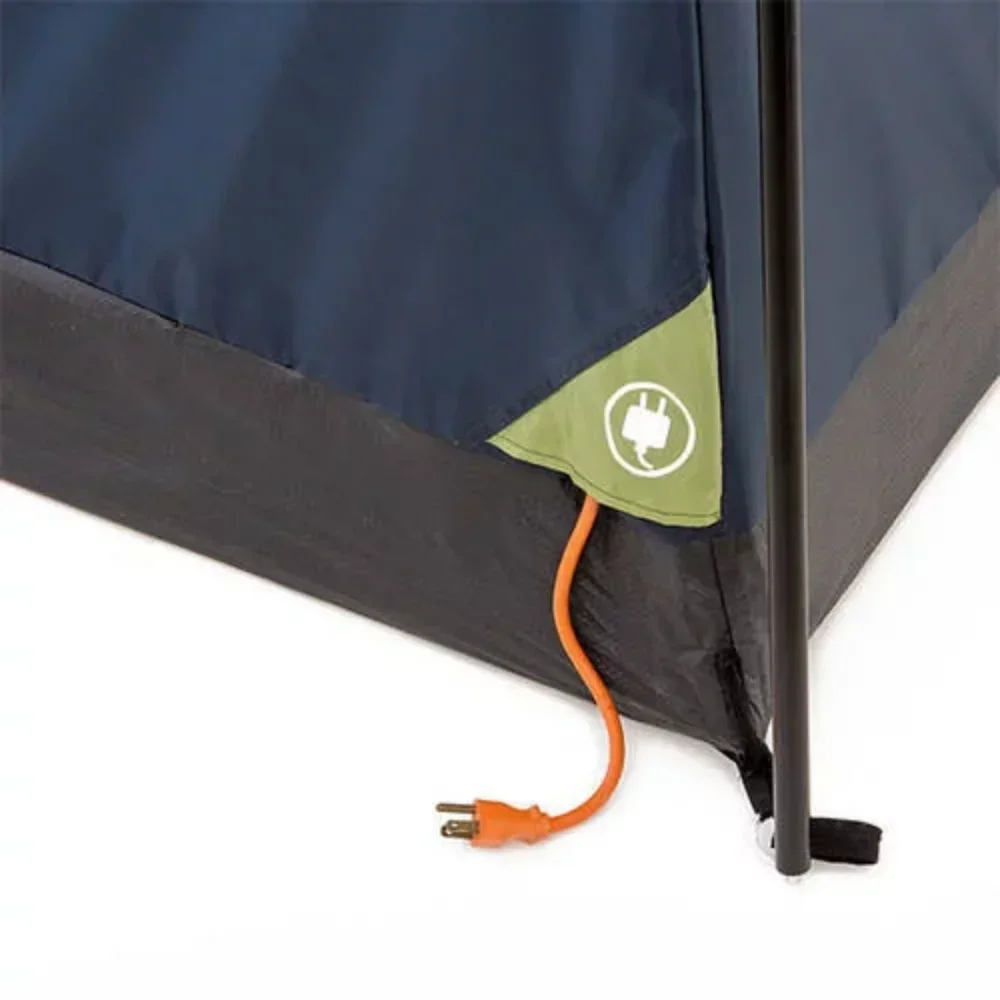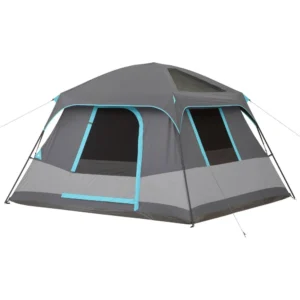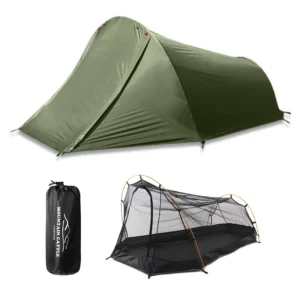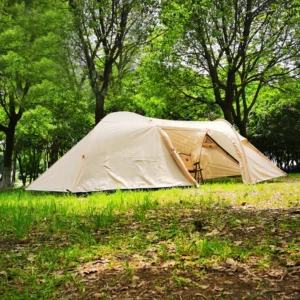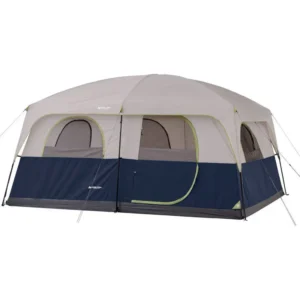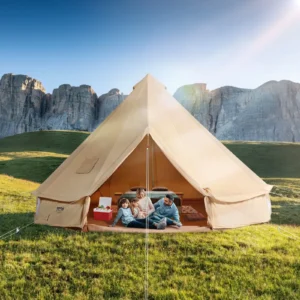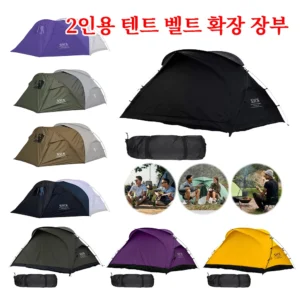Introduction to the Importance of Tent Peak Height for Comfort and Livability
Nothing transforms a camping experience quite like being able to stand upright in your tent. Peak height—the measurement from floor to the highest point of your tent—might seem like a minor detail when purchasing camping gear, but it dramatically impacts comfort and overall enjoyment during your outdoor adventures.
When you can stand up straight, stretch, and move freely inside your shelter, camping feels less like “roughing it” and more like creating a comfortable home away from home. This simple feature eliminates the hunched-over shuffle that many campers endure in standard tents, reducing backaches and frustration during longer trips.
The benefits of choosing a tent with generous headroom include:
- Easier changing of clothes without awkward contortions
- More comfortable movement during poor weather when you’re tent-bound
- Reduced feelings of claustrophobia for those sensitive to confined spaces
- Ability to use camp furniture and organize gear more effectively
- Better accommodation for taller campers who often feel cramped
After field-testing dozens of tents across various height ranges, the difference in comfort between standard low-profile designs (typically 36-42 inches/91-107 cm tall) and high-peak options (65+ inches/165+ cm) is remarkable. Understanding the different shelter options for two campers is especially important when considering peak height and overall comfort during your outdoor adventures.
Understanding Peak Height in Tents: What Constitutes “High”?
When shopping for tents with generous headroom, it helps to understand what measurements actually qualify as “high.” In the camping world, peak heights vary significantly based on tent style and intended use, with most tall designs offering at least 65 inches (165 cm) of clearance at their highest point.
Here’s a breakdown of typical peak heights across different tent categories:
| Tent Type | Typical Peak Height Range | Best For |
|---|---|---|
| Backpacking Tents | 36-42 inches (91-107 cm) | Ultralight hiking, minimal setup |
| Hiking Tents | 43-55 inches (109-140 cm) | Balance of portability and comfort |
| Family/Car Camping | 56-75 inches (142-190 cm) | Extended stays, comfort priority |
| Cabin Tents | 72+ inches (183+ cm) | Maximum livability, base camping |
To determine if a tent offers sufficient height for you personally, add 6-8 inches (15-20 cm) to your own height as a starting point. This extra space allows for comfortable movement without constantly brushing against the ceiling.
A critical distinction to understand is the difference between center peak height and usable standing space. Many dome tents advertise impressive peak heights, but this measurement applies only to the very center, with steeply sloping walls that limit where you can actually stand upright. In contrast, cabin-style tents with more vertical walls maximize the area where you can stand comfortably.
When evaluating various camping shelter options for two, consider both the peak measurement and the wall design to ensure you’re getting truly usable space rather than just an impressive number on the specifications sheet.
Why Tent Peak Height is Crucial for a Great Camping Experience
The benefits of choosing a tent with ample headroom extend far beyond the simple luxury of standing upright. A high-peak tent fundamentally transforms how you experience camping in several important ways:
Enhanced Movement Freedom
– Standing upright without hunching reduces back strain and fatigue
– Moving naturally without constantly ducking or bending prevents muscle tension
– Simpler entry and exit, especially important for campers with limited mobility
Practical Daily Comfort
– Changing clothes becomes dramatically easier and more dignified
– Morning and evening routines feel more like home and less like an expedition
– Rainy days spent inside feel less confining and more bearable
Improved Environmental Quality
– Better air circulation prevents stuffiness and reduces condensation
– Higher ceilings create temperature stratification, keeping sleeping areas cooler
– Increased volume dilutes cooking odors and morning breath
Gear Organization Benefits
– Vertical storage becomes possible, freeing up valuable floor space
– Taller equipment (camp chairs, portable tables) can be stored inside
– Hanging lights and organization systems from higher points improves visibility
Psychological Advantages
– Reduced feelings of claustrophobia, especially on longer trips
– More natural social interactions when multiple people can stand and move freely
– Creates a genuine “room” feeling rather than just a sleeping space
For families or groups, these benefits become even more pronounced. When evaluating if a 2-person tent provides enough space for your needs, height should be a primary consideration alongside floor area. The difference between a cramped shelter and a comfortable living space often comes down to those extra inches of peak height that allow for natural movement and better organization.
Top Tents with High Peak Height in the Camping Market
After extensive research and hands-on testing, we’ve identified the most impressive high-peak tents available today. Each offers exceptional standing room combined with other quality features to enhance your camping experience.
Cabin Lodge 10
Key Specifications:
– Peak Height: 86 inches (218 cm)
– Floor Dimensions: 14 × 10 feet (4.3 × 3 m)
– Capacity: 10 persons
– Weight: 32 lbs (14.5 kg)
– Season Rating: 3-season
Pros:
– Near-vertical walls maximize usable standing space
– Exceptional ventilation with multiple windows and roof vents
– Room divider included for privacy
– Color-coded poles simplify setup despite large size
– Electrical cord access port for convenient power
Cons:
– Heavy design not suitable for backpacking
– Takes up significant space in vehicle
– Requires large, flat campsite
– Premium price point
The Cabin Lodge exemplifies what a high-peak tent should be, with near-vertical walls that maintain the 86-inch ceiling height throughout much of the interior. Its weather resistance is impressive for such a large structure, with a full-coverage rainfly and sealed seams that have proven reliable even in sustained rainfall. The rugged 150D polyester floor withstands high traffic, while mesh panels provide excellent ventilation on warm days.
Dome Deluxe 6
Key Specifications:
– Peak Height: 72 inches (183 cm)
– Floor Dimensions: 10 × 10 feet (3 × 3 m)
– Capacity: 6 persons
– Weight: 17.5 lbs (7.9 kg)
– Season Rating: 3-season
Pros:
– Excellent balance of height and stability
– Quick 10-minute setup with color-coded system
– Superior wind resistance compared to cabin styles
– More portable than most high-peak options
– Affordable price point for features offered
Cons:
– Standing area limited to center portion
– Less interior volume than vertical-walled tents
– Door height lower than peak height
The Dome Deluxe offers a compelling middle ground between traditional dome tents and cabin styles, with a modified pole structure that creates more vertical walls while maintaining the wind resistance domes are known for. The 72-inch peak extends across enough of the ceiling to allow most adults to stand comfortably in the central area, making it a practical option for campers who want height without the bulk of a cabin tent.
Explorer Canvas Bell
Key Specifications:
– Peak Height: 98 inches (249 cm)
– Floor Dimensions: 13-foot diameter (4 m)
– Capacity: 4-6 persons
– Weight: 42 lbs (19 kg)
– Season Rating: 4-season
Pros:
– Exceptional central height
– Premium cotton canvas construction
– Superior insulation properties
– Distinctive aesthetic appeal
– Excellent four-season performance
Cons:
– Very heavy compared to synthetic options
– Longer drying time when wet
– Higher maintenance requirements
– Significant setup time
For campers seeking extreme height combined with traditional aesthetics, this canvas bell tent delivers with its towering 98-inch central peak. The breathable cotton canvas construction offers superior comfort in varied temperatures, naturally regulating humidity better than synthetic materials. While the weight makes it strictly a car camping option, the durability and all-season performance justify both the weight and premium price point for serious campers.
Instant Cabin 8
Key Specifications:
– Peak Height: 78 inches (198 cm)
– Floor Dimensions: 14 × 10 feet (4.3 × 3 m)
– Capacity: 8 persons
– Weight: 25 lbs (11.3 kg)
– Season Rating: 3-season
Pros:
– 60-second setup time thanks to pre-attached poles
– Near-vertical walls maximize standing area
– Multiple room configuration options
– Excellent ventilation with ground vents
– Integrated gear pockets and electrical port
Cons:
– Less durable in high winds than traditional designs
– Premium price point
– Bulky when packed despite quick setup
The Instant Cabin solves one of the primary complaints about high-peak tents—complex setup—with its innovative pre-attached pole system that enables a single person to erect this spacious shelter in under a minute. The 78-inch peak height combined with nearly vertical walls creates an exceptionally livable space where adults can move freely throughout most of the tent, not just in the center.
For campers interested in exploring more options with generous headroom, our tall stand-up camping tent collection offers additional models with similar benefits and various feature combinations to match your specific needs.
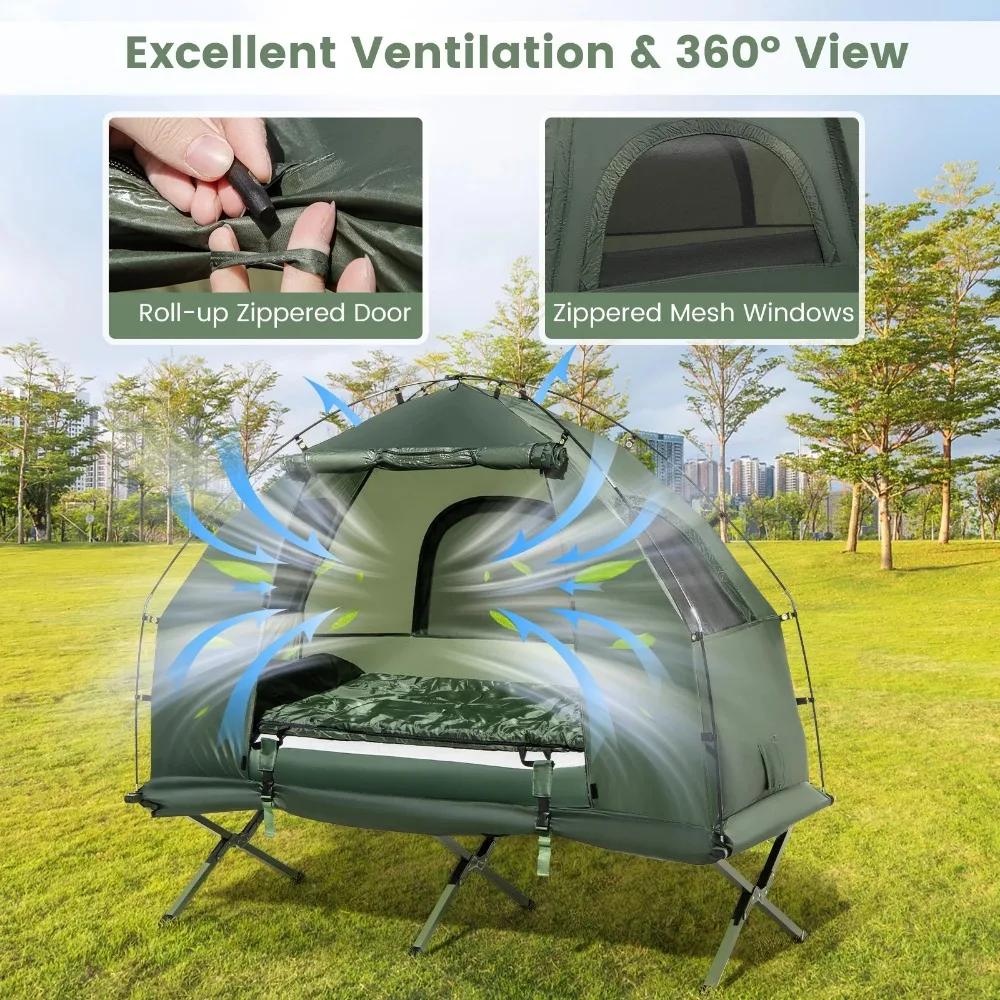
Comparison Table: Key Features of Top High Peak Tents
| Model | Peak Height | Capacity | Floor Area | Weight | Price Range | Season Rating | Setup Time | Standout Feature |
|---|---|---|---|---|---|---|---|---|
| Cabin Lodge 10 | 86” (218 cm) | 10 | 140 sq ft (13 sq m) | 32 lbs (14.5 kg) | $$$ | 3-season | 12 min | Maximum livable space |
| Dome Deluxe 6 | 72” (183 cm) | 6 | 100 sq ft (9.3 sq m) | 17.5 lbs (7.9 kg) | $$ | 3-season | 10 min | Best wind stability |
| Explorer Canvas Bell | 98” (249 cm) | 4-6 | 133 sq ft (12.3 sq m) | 42 lbs (19 kg) | $$$$ | 4-season | 15 min | Premium materials |
| Instant Cabin 8 | 78” (198 cm) | 8 | 140 sq ft (13 sq m) | 25 lbs (11.3 kg) | $$$ | 3-season | 1 min | Fastest setup time |
| Summit View 4 | 68” (173 cm) | 4 | 64 sq ft (5.9 sq m) | 10 lbs (4.5 kg) | $$ | 3-season | 8 min | Best weight-to-height ratio |
This comparison reveals several interesting patterns. The cabin and instant-setup designs consistently offer the most generous headroom, while dome structures sacrifice some peak height in exchange for better stability in adverse weather. For family camping, the Cabin Lodge and Instant Cabin present the best balance of space and ease of use, while weight-conscious campers might prefer the Summit View’s more modest dimensions despite its still-comfortable 68-inch peak.
When evaluating tents with upright entry designs for family camping, this kind of side-by-side comparison helps identify which features best align with your specific priorities and camping style.
Peak Height vs. Usable Space: The Role of Wall Design
Understanding the relationship between peak height measurement and actual usable space is crucial when selecting a high-peaked tent. The wall design dramatically impacts how much of that advertised height translates to functional standing room.
In cabin-style tents, the walls rise almost vertically from the floor before curving gently to the peak. This design maximizes the floor area where an average adult can stand at full height—often 70-80% of the total floor space. The tradeoff comes in wind resistance, as these boxy shapes catch more wind and require additional guylines and stakes for stability in stormy conditions.
Conversely, dome tents feature walls that slope more dramatically from their center peak. While they might advertise impressive center heights, the usable standing area might only be 30-40% of the floor space. The benefit comes in superior stability in high winds and better snow-shedding capabilities for winter camping.
To assess the actual usable height of a tent from specifications and images:
- Look for the wall angle in product descriptions (90° is vertical; lower angles mean more slope)
- Check the difference between center height and corner height (smaller differences indicate more vertical walls)
- Calculate the standing area—the area where a person of your height can stand comfortably upright
When considering larger shelter options like two-room camping tents, this understanding of usable space becomes even more important as you’ll want comfortable standing room in both compartments, not just at the central peak.
Capacity and Sleeping Arrangements in High-Peak Tents
When evaluating tent capacity claims, experienced campers know to take manufacturer ratings with a grain of salt. These ratings typically represent the maximum number of people who can sleep shoulder-to-shoulder in sleeping bags—not a comfortable arrangement for most camping trips.
For comfortable real-world use, consider these guidelines:
- Subtract 1-2 people from the manufacturer’s capacity rating
- Allow 20-25 square feet (1.9-2.3 sq m) of floor space per person for comfort
- Add extra space if you’re using air mattresses instead of sleeping pads
- Consider how gear storage needs will impact available sleeping space
In high-peak tents, the vertical space creates a psychological sense of roominess that can make even modest floor dimensions feel more comfortable. However, this doesn’t change the physical floor space needed for sleeping arrangements.
For privacy in multi-person setups, look for models with:
– Built-in room dividers (typically zippered fabric panels)
– Multiple doors for separate access to different areas
– Strategic window placement that maintains privacy while allowing ventilation
When choosing an appropriate compact shelter for two, remember that peak height affects not just standing comfort but also the overall sense of spaciousness even when you’re seated or lying down.
Seasonality and Weather Protection in Tall Tents
High-peak tents present unique considerations when it comes to weather resistance. Their larger surface area and taller profile can affect performance in different weather conditions:
Wind Performance
Taller tents naturally catch more wind, making proper setup and guying out essential. Look for:
– Additional guyout points along upper walls
– Reinforced pole sleeves and attachment points
– Wind-responsive flexibility in the frame
– Lower wind profile options for exposed campsites
Rain Protection
With more surface area for rain to hit, waterproofing becomes even more important:
– Look for rainfly materials with at least 1500mm hydrostatic head rating
– Sealed seams throughout, especially at the roof/wall junctions
– Adequate rainfly coverage over doors and windows
– Proper tension to prevent water pooling
Temperature Management
The increased interior volume affects temperature regulation:
– In summer: Better air circulation can mean cooler sleeping conditions
– In winter: More air to heat means less efficient warming from body heat
– Consider seasonal needs when selecting between mesh panels and solid walls
Though many high-peak tents are 3-season designs, several 4-season options exist with reinforced poles, stronger materials, and reduced mesh to handle snow loads and winter conditions. The waterproof camping tent options in our collection demonstrate how advanced materials can maintain weather resistance even in taller tent designs.
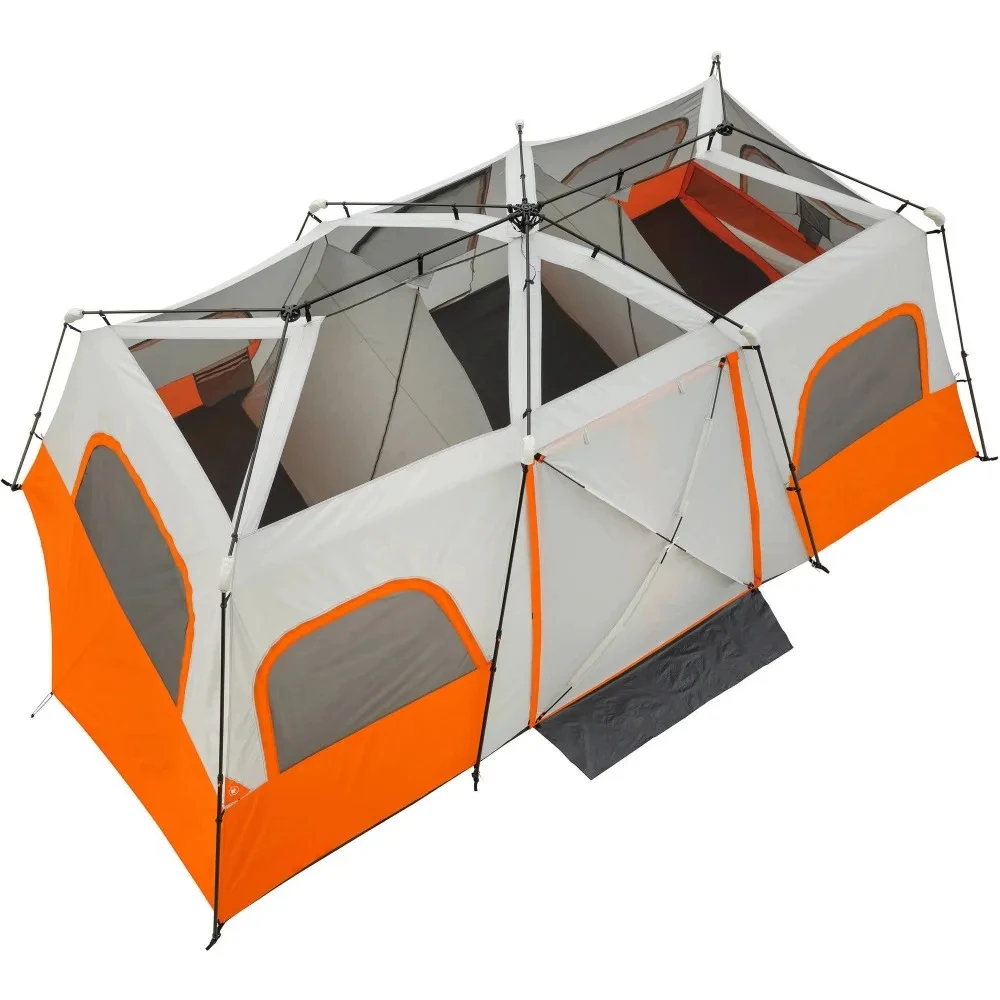
Ventilation and Airflow Optimization in High-Peak Tents
Proper ventilation becomes both more important and potentially more effective in high-peak tents. The increased volume creates opportunities for improved air circulation, but requires thoughtful design to prevent condensation and maintain comfort.
In well-designed tall tents, ventilation features work with the natural tendency of warm air to rise:
– High and low vents create a chimney effect for continuous air exchange
– Mesh ceiling panels allow hot air to escape while maintaining privacy
– Adjustable window openings provide cross-ventilation
– Ground-level vents bring in cooler air to replace rising warm air
To maximize ventilation benefits in high-peak designs:
– Position the tent to take advantage of prevailing breezes
– Use all available vents during warm weather
– Create cross-ventilation by opening windows on opposite sides
– Consider a tent with a partial or full mesh ceiling for stargazing and maximum airflow
For campers particularly concerned about ventilation, superior ventilation dome tents provide specialized designs that combine generous height with optimized airflow systems for maximum comfort in various weather conditions.
Setup Complexity: Are Taller Tents Harder to Pitch?
A common concern with high-peak tents is whether the additional height makes setup more difficult. While taller tents can present some unique challenges, modern designs have largely addressed these issues through innovative features:
Most tall cabin-style tents now use one of these user-friendly systems:
– Hub designs where poles connect to central junctions
– Color-coded poles and connection points
– Unified frame assemblies that expand as a unit
– Shock-corded poles that naturally find their connections
For solo campers concerned about managing a tall tent alone:
– Look for instant or pop-up designs that require minimal reaching
– Consider models with unified frame systems rather than individual poles
– Use setup tools like pole extenders if you’re shorter than the peak height
– Practice at home to develop an efficient technique
While setup time typically increases with tent size, many modern high-peak options can still be assembled in 10-15 minutes once you’re familiar with the process. For the ultimate in convenience, instant camping tents offer pre-attached pole designs that can reduce setup time to under a minute while still providing generous standing height.
Durability and Materials: What to Look For in a High-Quality Tall Tent
The materials used in high-peak tents significantly impact their performance, longevity, and weather resistance. When evaluating options, pay special attention to these components:
Body Materials
| Material | Advantages | Considerations |
|———-|————|—————-|
| Polyester | UV resistant, less stretching when wet | Less breathable than nylon |
| Nylon | Lightweight, high strength-to-weight ratio | Degrades with UV exposure |
| Canvas | Excellent insulation, naturally breathable | Heavy, requires weathering, longer dry time |
Floor Materials
Look for these features for maximum durability:
– Bathtub floor design that wraps up the sides
– Higher denier ratings (150D and above for family camping)
– Polyethylene or Oxford cloth for heavy-duty applications
– Factory-sealed seams or sealed seam tape
Pole Materials
| Material | Best For | Considerations |
|———-|———-|—————-|
| Fiberglass | Budget options, casual use | Less durable, may splinter |
| Aluminum | Balance of weight and strength | More expensive, conducts cold |
| Steel | Maximum stability in large tents | Heavy, potential for rust |
| Carbon Fiber | Premium lightweight options | Very expensive, less flexible |
For high-peak tents specifically, pole diameter and wall thickness become even more important due to the additional leverage created by the height. Look for larger diameter poles (10mm+) and reinforcements at junction points where stress concentrates.
Many canvas camping tents offer exceptional durability combined with generous peak heights, representing an investment that can provide decades of use with proper care.
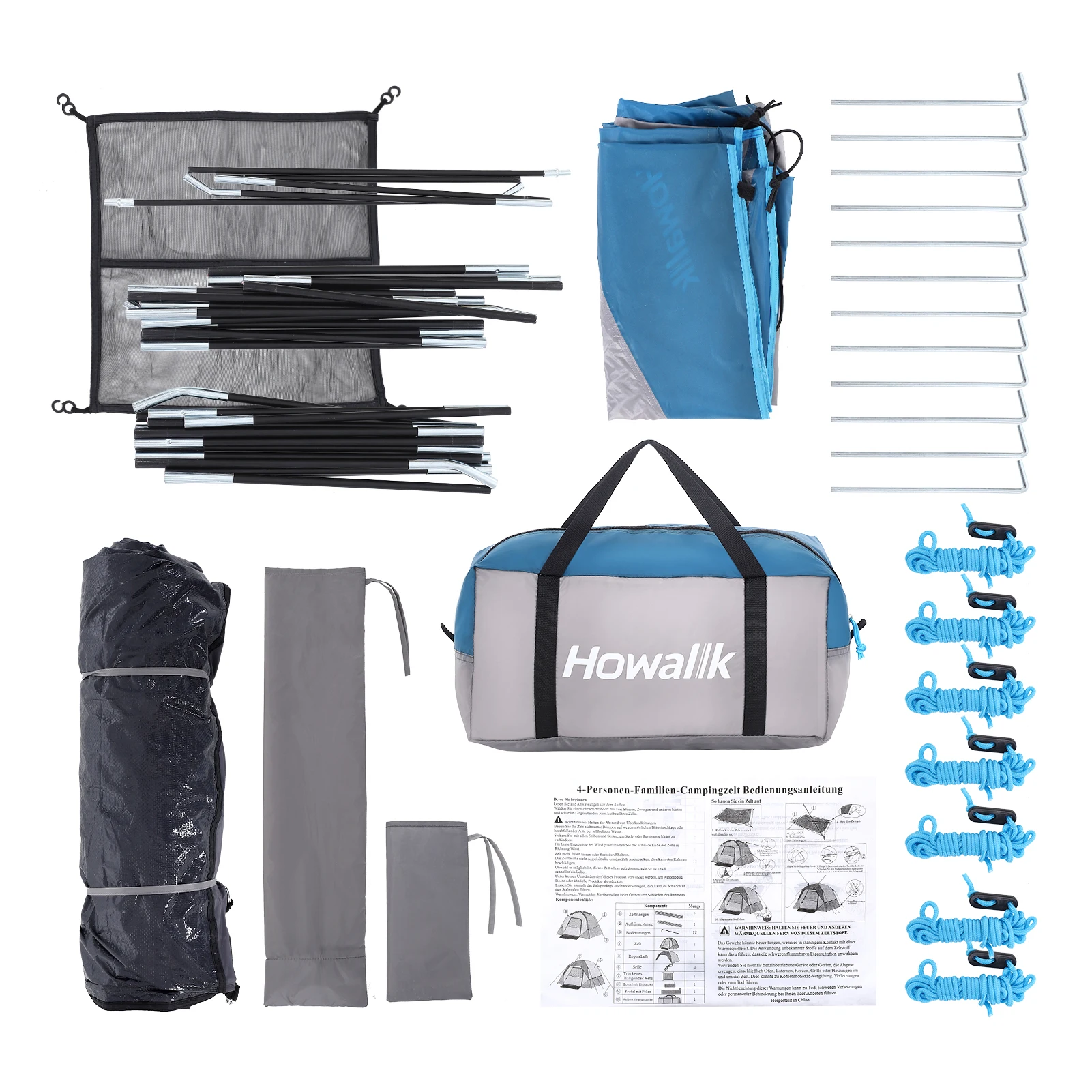
Weight and Packed Size Considerations
The generous dimensions of high-peak tents inevitably come with trade-offs in weight and packability. Understanding these limitations helps set realistic expectations:
Most tall family tents weigh between 15-35 pounds (6.8-15.9 kg), placing them firmly in the car camping category. This weight results from:
– More pole material required for structural integrity
– Additional fabric for walls and rainfly
– Heavier-duty floor materials to support increased use
– Extra features like room dividers and multiple doors
Packed dimensions typically range from:
– Length: 24-36 inches (61-91 cm)
– Diameter: 10-14 inches (25-36 cm)
Transportation considerations include:
– Vehicle space requirements (most require trunk or cargo area space)
– Distribution among multiple packs for group carrying
– Two-person carrying for heavier models
– Storage containers for home organization between trips
For basecamp-style camping where you set up once for an extended stay, these weight considerations become less important than the comfort benefits of standing height. However, if you’ll be moving camp frequently, carefully weigh the trade-offs between peak height and portability.
Types of Tents Known for High Peak Heights
Different tent designs approach the challenge of providing standing room in unique ways, each with distinct advantages:
Cabin Tents
– Near-vertical walls maximize usable interior volume
– Typically offer the highest percentage of standing-height floor area
– Often include room dividers for privacy
– Best suited for extended stays and family camping
– Generally heavier but provide maximum livability
Large Dome Tents
– Modified dome structures with steeper wall angles
– Balance between stability and standing height
– Superior wind resistance compared to cabin designs
– More portable than cabin styles
– Standing room limited to central area
Instant/Pop-Up Tents
– Pre-attached pole systems for lightning-fast setup
– Growing segment with improving height options
– Great for frequent moves or brief stays
– Typically feature cabin-style designs with vertical walls
– Premium price point reflects convenience factor
Bell Tents
– Traditional canvas designs with extreme center height
– Single center pole creates distinctive profile
– Excellent ventilation and aesthetic appeal
– Heavy but extremely durable
– Superior temperature regulation in varied climates
Tunnel Tents
– Arched pole design creates consistent height along ridge
– Multiple arches provide extended standing height areas
– Excellent space-to-weight ratio
– Good performance in mild to moderate wind
– Easy to separate into functional areas
For those prioritizing quick setup alongside generous headroom, easy setup camping tents combine these benefits into versatile options suitable for various camping styles.
Tips for Enhancing Space and Comfort in Your Tall Tent
Once you’ve selected a high-peak tent, these strategies will help maximize its benefits:
Create vertical storage zones by hanging organizer pockets or mesh shelves from ceiling attachment points, keeping essentials off the floor.
Use collapsible furniture that takes advantage of the height while minimizing floor space consumption—folding tables, compact chairs, and hanging organizers.
Position lighting strategically at different heights: ambient light near the ceiling, task lighting at mid-height, and personal lights near sleeping areas.
Establish clear pathways between sleeping areas and doors to maintain easy movement, especially important in larger group setups.
Use contrasting floor mats to designate different functional areas—sleeping, changing, gear storage—while adding comfort underfoot.
Install a simple clothesline across upper areas for drying damp items without consuming floor space.
Create privacy zones with lightweight fabric panels hung from ceiling attachment points when standard room dividers aren’t enough.
Position air mattresses against walls to maximize central floor space while maintaining comfortable sleeping areas.
These enhancements transform a simple tall tent into a genuinely comfortable living space that feels more like a portable cabin than traditional camping accommodation.
Tall / Stand Up Camping Tent, Two Room Camping Tent
$407.93 Select options This product has multiple variants. The options may be chosen on the product pageCompact Backpacking Tent, Lightweight Backpacking Tent, Waterproof Camping Tent
$335.52 Select options This product has multiple variants. The options may be chosen on the product pageCamping Tent with Vestibule, Waterproof Camping Tent
Price range: $407.89 through $479.48 Select options This product has multiple variants. The options may be chosen on the product page- $476.52 Select options This product has multiple variants. The options may be chosen on the product page
- $1,221.93 Select options This product has multiple variants. The options may be chosen on the product page
Backpacking Tent with Vestibule, Trekking Pole Backpacking Tent, Waterproof Camping Tent
Price range: $271.99 through $519.52 Select options This product has multiple variants. The options may be chosen on the product page
Are Tall Tents Harder to Set Up? Practical Considerations
While high-peak tents do present some unique setup challenges, modern designs have largely solved the most common issues. Here’s what you need to know:
Do I need to be tall to set up a tall tent?
No. Most designs use bottom-up assembly where you connect poles at ground level first, then lift the structure as it takes shape. Even shorter campers can successfully manage tall tents with proper technique.
How many people are typically needed?
For most family-sized high-peak tents (8-10 person capacity), two adults can manage setup comfortably. Smaller 4-6 person models can often be handled solo, while the largest cabin tents (12+ person) work best with 3-4 people helping.
What about windy conditions?
Wind significantly complicates setup for tall tents. Best practices include:
– Starting with the tent back facing the wind
– Securing the first corner immediately
– Adding stakes progressively as you build
– Having a partner hold sections steady during critical connections
– Using all guy lines, even in seemingly mild conditions
Are there helpful tools for easier setup?
Several accessories can simplify the process:
– Pole extenders for reaching high connection points
– Rubber mallets for secure staking
– Freestanding setup templates or footprint guides
– Extra-long stakes for better anchoring of tall structures
For campers concerned about setup complexity, learning proper lightweight tent setup techniques provides foundational skills that apply to larger shelters as well, just on a different scale.
Frequently Asked Questions About Tents with High Peak Height
How much peak height do I really need based on my height?
A good rule of thumb is to choose a tent with a peak height at least 6-8 inches (15-20 cm) above your own height. This allows for comfortable movement without stooping or brushing against the ceiling. For example, someone 5‘10” (178 cm) tall should look for a tent with at least 74-78 inches (188-198 cm) of peak height.
Do tall tents catch more wind?
Yes. Their larger profile presents more surface area for wind to push against. This makes proper guying and staking essential, particularly for cabin-style tents with vertical walls. Many tall tents include additional guy points along upper walls specifically to enhance wind stability.
Can tall tents be used for backpacking?
Generally no. The materials needed to create stable high-peak structures add considerable weight, typically pushing these tents well beyond backpacking weight limits of 2-4 pounds (0.9-1.8 kg). Most high-peak tents weigh 15+ pounds (6.8+ kg) and are designed for car camping.
What’s the difference between peak height and headroom?
Peak height is simply the highest measurement from floor to ceiling, typically at the center of the tent. Headroom refers to the usable space where average adults can stand comfortably without stooping, which depends both on peak height and wall angles. A tent with a 72-inch peak but steep walls might offer less functional headroom than a 68-inch tent with more vertical walls.
Are tall tents suitable for winter camping?
It depends on their specific design. The larger interior volume can be harder to heat, but many tall tents—especially canvas options—offer excellent insulation. Look specifically for 4-season ratings and features like snow-shedding roof designs, stronger poles, and reduced mesh panels if winter camping is your goal.
Key Features to Look For When Purchasing a High-Peak Tent
When evaluating tall tents, this checklist will help ensure you select a model that maximizes the benefits of additional height:
✓ Minimum peak height that exceeds your own height by at least 6-8 inches (15-20 cm)
✓ Wall angle of at least 70-80 degrees to maximize usable standing area (closer to 90° is better)
✓ Floor area appropriate for your group size (20-25 sq ft or 1.9-2.3 sq m per person)
✓ Door height that matches or nearly matches peak height to prevent ducking during entry/exit
✓ Windows positioned at both high and low levels for optimal ventilation and temperature control
✓ Vestibule height sufficient for sitting or crouching while managing gear or removing boots
✓ Pole material and diameter appropriate for the tent size (aluminum or steel for largest models)
✓ Multiple guy-out points along upper walls for wind stability
✓ Full-coverage rainfly that extends to ground level on all sides
✓ Weather-appropriate features like sealed seams, bathtub floors, and storm flaps over zippers
✓ Sufficient warranty coverage (typically 1-2 years for standard use)
High-quality dome camping tent options increasingly combine impressive peak heights with the superior stability these designs are known for, offering an excellent compromise for those concerned about weather performance.
The right high-peak tent transforms camping from merely sleeping outdoors to creating a comfortable, functional living space that enhances your connection with nature without sacrificing basic comforts. By focusing on usable space rather than just maximum measurements, you’ll find a tent that truly lets you stand up and stretch out on your next camping adventure.

